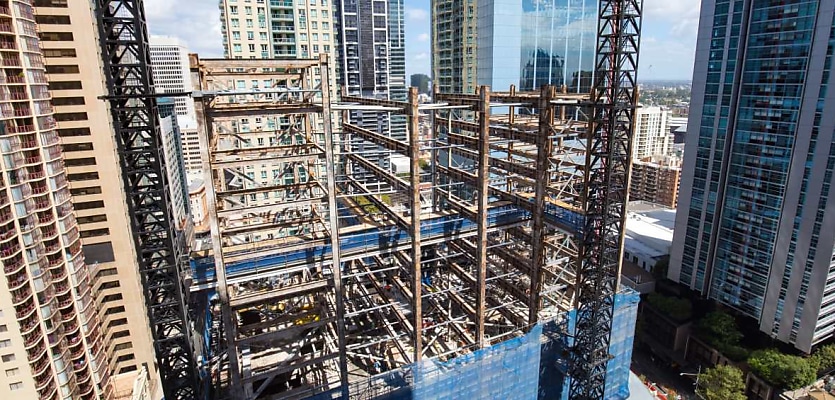In an era of significant macro, geopolitical and technological disruption, construction costs will continue to surge as regulatory pressures mount, a new report from DLA Piper has revealed.
From pandemic restrictions to prolonged supply chain disruption, inflation increases, an energy crisis, volatile commodity prices and conflict in Russia and Ukraine, the global construction industry has endured a “severe stress test” over a turbulent two years, according to new research.
The DLA Piper report, Constructing the Future: Striving and thriving in the era of disruption, shows that the Australian construction sector has faced price escalation in the region of 70 per cent for some materials.
The report, which surveyed senior construction executives globally, found that the biggest risk for the construction sector in the Asia-Pacific region is the rising cost of raw materials, according to 53 per cent of respondents, followed by local regulations and taxes (53 per cent).
Perth-based Richard Edwards, DLA Piper global co-head of construction, infrastructure and engineering disputes, said that these key risks would continue to have varying effects.
“In Australia, the key development risks concern price, supply chains and financing. This is now having a knock-on effect in insolvencies. While it appears there has been some recent improvement in supply chains, which is reflected in falling prices in certain parts of the shipping market, these will take a while to wash through,” he said.
“In terms of financing, interest rates are increasing along with price. We’re seeing developments here in Australia being put off or recast in circumstances where previously estimated costs are no longer achievable. Projects are being modified to make them smaller or simpler.”
Speaking within the report, Australian Constructors Association chief executive Jon Davies said that the pandemic also has numerous impacts on the Australian construction sector.
“Material price escalation has become a major issue — more in the past 12 months than at the start of the pandemic. We’ve identified price escalation in the region of 70 per cent for some materials. That has fed through into growing insolvency in the construction sector,” he explained.
“One of the problems is that most materials come to Australia by boat, but the pandemic put a crunch on international logistics. The price for a container to Australia went from approximately $2,000 to upwards of $15,000. Second, the war in Ukraine had significant implications for a range of materials, including ones you wouldn’t think about, such as lift parts. And another issue is rising interest rates. All of this has a sizable impact for developers.”
Additionally, 54 per cent of respondents across the globe said that securing construction projects without fixed-price budgets is a top priority in the coming 18 months, overtaking government contracts, which had been their top strategy for the preceding 18 months. Eighty-eight per cent of APAC respondents also said they anticipate price increases for materials in the coming 18 months.
“Multi-decade-high increases in inflation have triggered a tightening of financial conditions. Higher borrowing costs pose risks to near-term construction costs and even debt distress among poorly capitalised construction firms, contractors, material suppliers and merchants,” the report stated.
“In addition, China’s COVID-19 outbreaks and strict lockdowns have stifled manufacturing output both within the country and across global supply chains, reducing the availability of construction materials and increasing costs.”
Whilst government infrastructure spending commitments offer “lucrative opportunities” for the construction centre, these can often carry potential risk, with the report noting that “bold political promises” sometimes go without execution.
“Deficit-financed commitments in a rising interest rate environment will increase government costs and leave projects vulnerable, which can create uncertainty for the construction sector. This reality is reflected in our survey, which shows that long-term strategic investment priorities are shifting.
“Just over half (51 per cent) of respondents say that government infrastructure contracts ranked as one of their top three investment strategies in the past 18 months (51 per cent), followed by long-term, non-fixed price projects (45 per cent),” the report stated.
“Looking forward, the situation flips — in the coming 18 months, 54 per cent say securing non-fixed-price projects will be in their top three priorities, above government contracts (49 per cent).”
Furthermore, the report found that while regulatory pressure is likely to rise, there were concerns about a lack of standardised metrics for reaching environmental, social and governance (ESG) targets. A further 55 per cent of respondents in APAC identified challenges in tracking and measuring ESG progress.
“Compliance with new regulations like emerging ESG frameworks is becoming a must-have in government contracts, and this is likely to spread, but some respondents have expressed concerns about a lack of metrics to make effective comparisons and adequately prepare,” Mr Edwards added.
Australia specifically is also going through a period of “rapid catch-up”, added Mr Davies.
“Thankfully, the new federal government has committed to net zero by 2050 and is starting to put some detail behind that. On the social side, we’re probably a bit better — there’s a focus on how investment can drive improved social outcomes. One of the initiatives we’re involved with is called the Construction Industry Culture Taskforce, which addresses improving the culture of the industry,” he said.
“There’s a vital need to substantially change the way the industry operates, whether it’s the environment, technology, productivity, capability or capacity. That means fundamental disruption in how we procure, deliver and govern projects. This will take a bold commitment — we can’t just go for incremental change anymore.”

Never miss a beat with
Stay across what’s happening in the Australian commercial property market by signing up to receive industry-specific news and policy alerts, agency updates, and insights from reb.
Subscribe to reb Commercial:









You are not authorised to post comments.
Comments will undergo moderation before they get published.